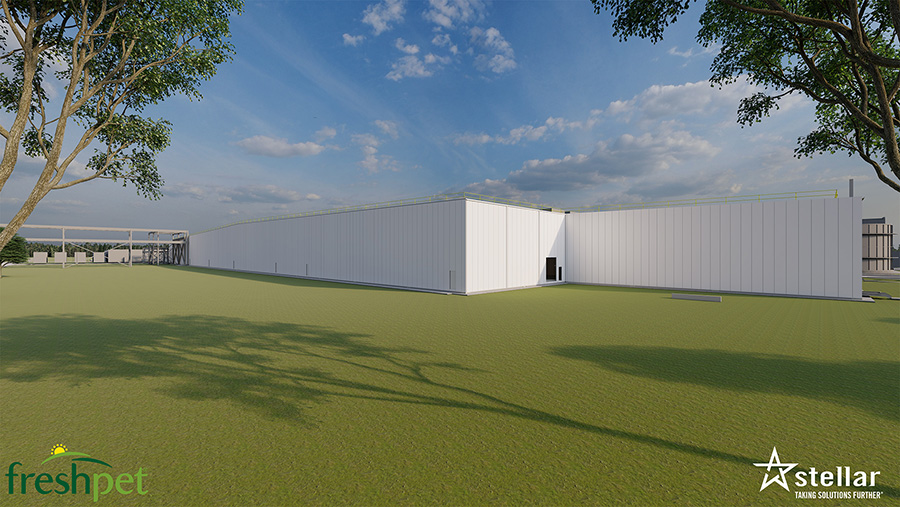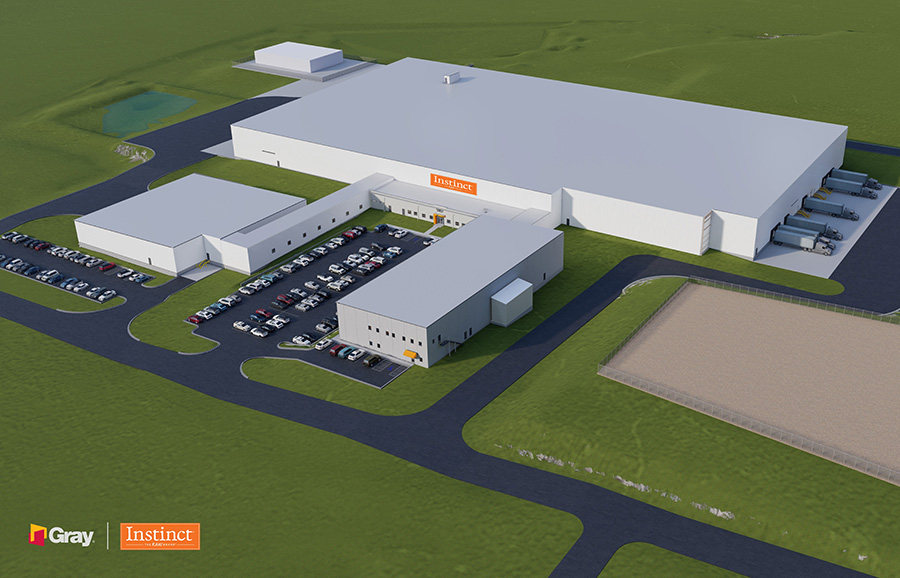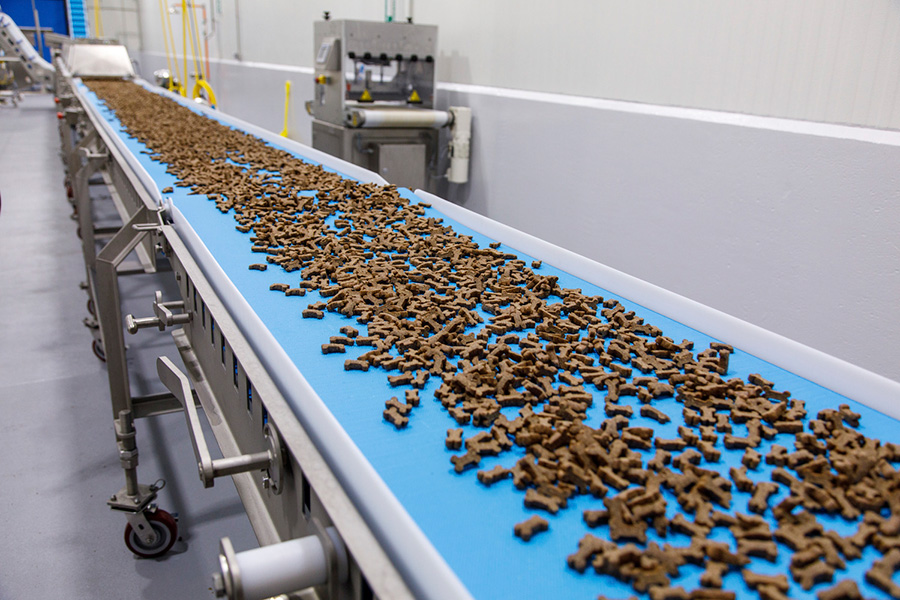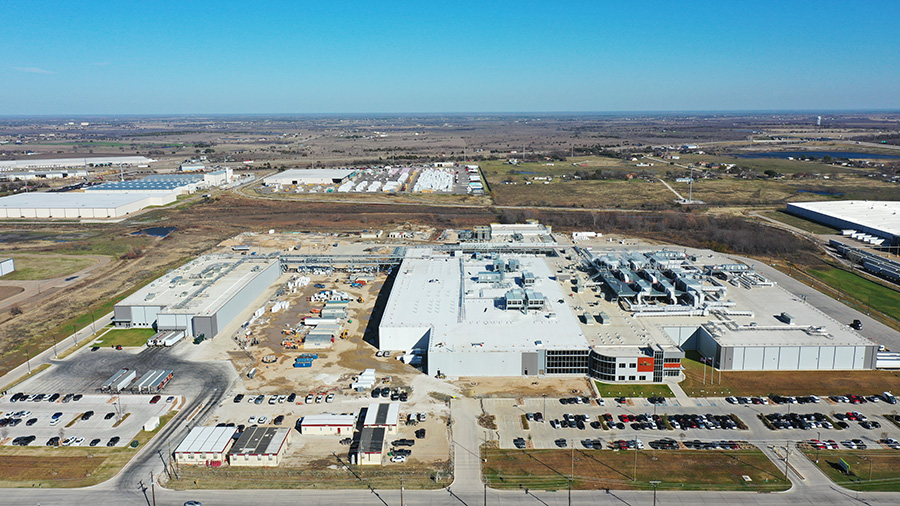This article was published in the March 2024 issue of Pet Food Processing. Read it and other articles from this issue in our March digital edition.
As consumers continue to increase their ownership of pets, demand for pet nutritional products has continued to rise, forcing many processors to invest in their operations. In 2023, Pet Food Processing covered 27 operational announcements from pet food manufacturers, detailing plans to invest in capacity, expand existing facilities and construct greenfield plants.
With demand for pet food expected to continue its rise, more processors are looking into their operations, only to face the dauntless task of finding the right construction partner.
Freshpet, Secaucus, NJ, recently embarked on this journey when the company decided to expand its production facility in Ennis, Texas. According to Greg Schramm, director of project engineering at Freshpet, the company’s significant growth, as well as increasing demand for fresh pet foods, were significant factors in its selection of its partner.
“Due to the fast pace of Freshpet’s growth and the need of product to support that growth, our construction partner needed the resources and experience to execute an organized, quality, low risk ‘fast track’ project,” Schramm said. “The company’s preference was a construction partner that had significant self-performance capabilities, which would allow the partner to better control costs and schedule.”

Freshpet selected Stellar as its partner to quickly expand its fresh pet food plant in Ennis, Texas.
|The company eventually chose Stellar, a construction firm headquartered in Jacksonville, Fla. Stellar broke ground on the expansion in March 2023 with plans to add 200,000 square feet to Freshpet’s facility.
This project is just one of the many successful partnerships between pet food processors and construction firms. But, in order for these projects to be a success, many factors must be taken into consideration.
Leveraging experience
When beginning the search for a construction partner, experience is critical. Most processes and equipment in the pet nutrition industry have evolved from the human food space, meaning pet food facilities have many similarities to those built for human food. But it’s not enough for a partner to have experience in the human food and beverage industry — they must also have expertise in pet food.
“The right partner should have specific experience in the pet food industry along with experts in industry standards and processing requirements,” said Tom Rychlewski, vice president, regional operations, Food & Beverage at CRB, Kansas City, Mo. “Pet food companies should consider their potential partners’ regulatory and food safety expertise. This will be key in the project from start to finish, so it’s best to have the proper knowledge from the beginning.”
CRB leverages its experience in various industries, including food and beverage, pet food, biotechnology, pharmaceutical and others, to provide a range of services. For facility construction, it offers a design-build service that marries design and construction management with collaboration from vendors, trade partners and owners throughout all phases of a project.
Freshpet took Stellar’s experience into account when deciding which partner to choose. According to Schramm, the company examined the percentage of projects Stellar had completed in the food and beverage and pet food segments, as well as data from its larger projects completed within the past five years.

Instinct Pet Food selected Gray to design and construct its Center of Excellence in Lincoln, Neb.
|“It’s critical that there are people within the team that understand what the operational needs are beyond just the building blocks,” said Brett Goode, executive vice president, Food and Beverage at Gray. “We have subject matter experts, some of which have even worked in the pet food industry for a long time or worked for some of our customers, and they bring practical knowledge beyond just the building blocks of the building. These experts know the operational components of operating the facility after it’s built, so they tend to participate in the design at an early stage to set those projects up for success.”
As well as experience, it’s important that processors find a partner that can offer them additional services to fully round-out an entire project. Through Gray’s family of companies, it provides not only design and construction services, but also integrated controls and robotics, equipment manufacturing, process engineering, automation and more.
“As our customers diversified and consolidated, some had robust engineering capabilities and internal capacity, and some didn’t,” Goode shared. “Through this, we realized that we needed to provide our customers with additional services, not only to deliver on time and on budget, but really to innovate because some customers don’t have that internal expertise anymore.”
Gray most recently utilized its family of companies on its project with Hill’s Pet Nutrition, Overland Park, Kan. The company selected Gray to take the lead in developing its new wet pet food processing facility in Tonganoxie, Kan., which broke ground in 2021 and began operations in October 2023. In developing the facility, Gray leveraged its manufacturing capabilities to provide custom design and fabrication for more than 25 stainless-steel platforms on which to house Hill’s equipment.
“We have services that actually manufacture the equipment and provide processors with tangible materials to put in their facilities,” Goode added. “With this, we’re trying to go a little step further and add value to our customers.”
CRB also offers a wealth of additional services encompassing project planning, operations improvement, food safety and regulatory consulting, architecture, engineering, modeling, procurement, control systems integration, and sustainability offerings.
“We strive to be a single resource to support our clients throughout all stages of a project life cycle,” Rychlewski said. “CRB engages from the project’s inception, offering support in strategic facility planning, risk assessments, and facility consolidation or optimization. Whether a pet food manufacturer is expanding a new production line or starting a new facility, our design teams can handle the building design, layout, equipment specification and facility modeling, all while drawing knowledge from their deep expertise in the pet food industry.”
Schramm highlighted that processors should commit serious time toward due diligence before selecting the right partner, as Freshpet did. The company evaluated potential partners’ safety programs, experience, values, staffing, quality control programs, site construction management structure and practices, and cost and schedule projections. Schramm also shared that companies can get a good idea of a partner’s work and experience by visiting their project sites or a completed facility.
“I would recommend that the processor invest the time up front to determine what factors are important to the organization and the project, and use due diligence in evaluating the construction partner before the project is initiated,” he said. “Changes to construction partners in the middle of the project can be very complicated and costly.”
A true partnership
Constructing, or even just expanding, a facility is an extremely complex process. Between all those involved at the pet food company and the various partners within the construction firm, things can easily become disjointed. To avoid this, facility projects must be approached as highly collaborative partnerships.
Through its family of companies, Gray aims to do just this, according to Seth Tamme, manager, business development, Food & Beverage at Gray.
“We want to be an extension of resources and expertise to the existing engineering or construction people within,” said Seth Tamme of Gray.
“We’ve built this great family of companies to really just be an extension of our customers,” he shared. “We don’t look to come in and bring a new team to our customers. We want to be an extension of resources and expertise to the existing engineering or construction people within.”
The company also utilizes its subject-matter experts to provide additional perspectives on a project.
“The experience and expertise our team brings allows us to see if things can be done just a little bit differently,” Tamme said. “We’re not going to change their process, but what we’re going to do is provide innovative ways for efficiencies based on our expertise and knowledge in the industry. Because we’re not ingrained in their process on a day-to-day basis, we’re able to really take a step back and bring that added value of what we’ve seen in the industry beyond just their own minds.”
In adding expertise to a pet food processor’s existing knowledge, Gray ensures that every aspect of a project is discussed with both parties, eliminating possible snags from ground-breaking to ribbon cutting.

Tuffy’s Pet Treats selected CRB as its construction partner given the company’s extensive experience in food and beverage and pet food.
| Source: CRBTrue partnership is also of high importance for CRB. Leveraging its design and construction know-how, CRB adds on to a customer’s existing expertise. For example, Perham, Minn.-based KLN Family Brands sought CRB’s expertise for its new Tuffy’s Pet Treat facility located in Delano, Minn. By focusing on Tuffy’s dedication to high food safety, CRB made the company realize that renovating an existing facility would force the brand to compromise on its mission, and then proposed an alternative — building a greenfield facility.
“We bring world class expertise to work together, as partners, with our clients to help them meet their challenging needs,” Rychlewski said. “Our clients know their products best. However, when CRB brings our broad breath of experience and expertise to the table the solutions are unparalleled. Owners invest a lot of capital in their projects, and we are committed to helping them consider industry best practices, cost, ease of use, constructability, sustainability, time to implement, and level of automation required.”
Top recommendations
As the saying goes, communication is key, and this cannot be understated when it comes to constructing a manufacturing facility. Schramm noted that Freshpet clearly defined the scope of its project with Stellar early in the process.
“Even if a design-build partner with strong design and construction capabilities is chosen, it remains important that the pet food company clearly defines the project expectations and requirements as early as possible in the project life,” he said. “Setting the project expectations reduces the risks of schedule delays and cost control and sets up the company and design-builder for a successful project.”
To ensure this, Freshpet contracted Stellar through a DBIA (Design-Build Institute of America) contract with a GMP (Guaranteed Maximum Price) attachment. This, according to Schramm, defined the communication protocols between Freshpet and Stellar, as well as established project governance, the project’s scope and the design-builder construction costs.

Freshpet is leveraging Stellar’s expertise to expand its production facility, allowing it to keep pace with increasing demand for fresh pet foods.
| Source: Freshpet
“By clearly defining the project, it allows the company and the design-builder to focus on project execution and schedule,” he said.
Tamme recommends that companies evaluate their own processes, from raw material receiving and food safety to manufacturing, packaging and beyond, and ensure their facilities include built-in flexibility. This means considering the future, whether that be innovative technologies on the horizon, like artificial intelligence (AI), or possible fluctuations in consumer demand.
“It’s not just understanding today’s process, but what does it look like in five years, 10 years or 20 years?” he said. “And then finding the right partner that’s not designing and building for today. You want to hit today’s needs and also really look into the future.
“We’ve designed facilities in which the innovation and technology aren’t there yet in that industry, but we’ve designed the space for it and we’re going to help them as that innovation comes along to engage that technology within their facility,” Tamme added. “That’s a huge reason for our great family of companies: we don’t want to just be a constructor — we want to look toward the future.”
A great recent example of this is the company’s project with Hill’s, in which Gray purposely included advanced technology, like automation, robotics systems and AI, as well as additional space for future expansion.
CRB also ingrained flexibility into Tuffy’s Delano facility. Rather than rely on load-bearing walls, the company installed horizontal beams to support the roof’s structure, allowing Tuffy’s to reconfigure the plant’s interior as demand changes, without damaging the structural integrity.
As consumer demand for pet food continues to evolve, adding space and flexibility into a facility design can be imperative to a company’s future growth.
“With pet food there’s been a change in the way consumers behave and purchase for their pets, especially during COVID-19 and coming out of COVID-19, whether it’s dietary restrictions, allergens, high-end or low-end type products, etc,” Tamme said. “Being able to design and build facilities that have those flexibilities in mind should be first and foremost.”
Goode echoed this sentiment, concluding, “At the end of the day, we do not want to leave a processor with a facility that doesn’t deliver in the future. That actually hinders their growth. We’re being very sensitive to their needs for today and we have line of sight into innovation and technology to be able to provide those options.”
Before a shovel hits the ground
With all the considerations and due diligence that goes into constructing a facility, the earlier processors can bring in a construction partner, the better.
Hill’s Pet Nutrition did just this with Gray when developing its new plant in Tonganoxie. The result? A highly technologically advanced, ultramodern, wet pet food plant set to support Hill’s current capabilities in wet production, as well as provide it with enhanced automation and flexibility to keep pace with the industry’s future.
“It was a very sophisticated project, full of a lot of new technologies and innovation,” Tamme said. “But the fact that we were able to partner with them at stage zero, or phase zero, on that project really led to a successful partnership. The amount of work that was done up front with our cohesive teams before a shovel even hit the ground drove that to be a successful project in the long term.”
For Gray, getting in at “phase zero” sets both it and the pet food company up for ultimate success. It allows Gray to truly dive into the company’s current processes, equipment needs and anticipated demand to provide a facility that supports a processor for the long-term.
“Bringing your partner in early can help you develop a business case/proforma, align on scope and budget, and support site selection, providing owners with facility criteria and preventing surprises after the property is purchased,” Rychlewski said.
Additionally, bringing an expert in earlier can also help processors figure out if they even need to expand their operation. According to Rychlewski, expansion is not always the answer.
“For some customers it is a requirement, but often production scheduling and manufacturing campaigns optimization or de-bottlenecking can give owners more throughput where, at the surface, it was not available,” he shared.
Read more about pet food and treat processing on our Operations page.





